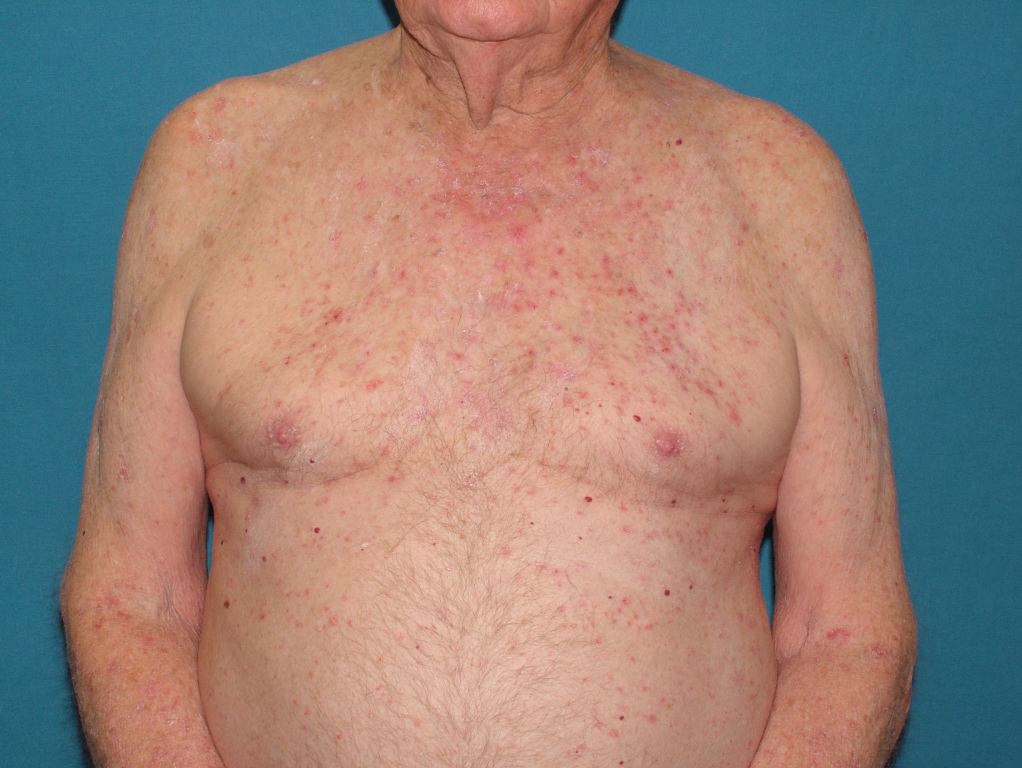[1]
Wenzel FG, Horn TD. Nonneoplastic disorders of the eccrine glands. Journal of the American Academy of Dermatology. 1998 Jan:38(1):1-17; quiz 18-20
[PubMed PMID: 9448199]
[2]
El Anzi O, Hassam B. [Widespread miliaria crystallina: about a case]. The Pan African medical journal. 2018:30():69. doi: 10.11604/pamj.2018.30.69.15383. Epub 2018 May 28
[PubMed PMID: 30344853]
Level 3 (low-level) evidence
[3]
LYONS RE, LEVINE R, AULD D. Miliaria rubra, a manifestation of staphylococcal disease. Archives of dermatology. 1962 Sep:86():282-6
[PubMed PMID: 14467655]
[4]
Ale I, Lachapelle JM, Maibach HI. Skin tolerability associated with transdermal drug delivery systems: an overview. Advances in therapy. 2009 Oct:26(10):920-35. doi: 10.1007/s12325-009-0075-9. Epub 2009 Nov 27
[PubMed PMID: 19967501]
Level 3 (low-level) evidence
[5]
Carter R 3rd, Garcia AM, Souhan BE. Patients presenting with miliaria while wearing flame resistant clothing in high ambient temperatures: a case series. Journal of medical case reports. 2011 Sep 22:5():474. doi: 10.1186/1752-1947-5-474. Epub 2011 Sep 22
[PubMed PMID: 21939537]
Level 2 (mid-level) evidence
[6]
Onal H, Adal E, Ersen A, Onal Z, Keskindemirci G. Miliaria rubra and thrombocytosis in pseudohypoaldosteronism: case report. Platelets. 2012:23(8):645-7. doi: 10.3109/09537104.2011.641624. Epub 2011 Dec 13
[PubMed PMID: 22150373]
Level 3 (low-level) evidence
[7]
Urbatsch A,Paller AS, Pustular miliaria rubra: a specific cutaneous finding of type I pseudohypoaldosteronism. Pediatric dermatology. 2002 Jul-Aug
[PubMed PMID: 12220275]
[8]
Akcakus M, Koklu E, Poyrazoglu H, Kurtoglu S. Newborn with pseudohypoaldosteronism and miliaria rubra. International journal of dermatology. 2006 Dec:45(12):1432-4
[PubMed PMID: 17184247]
[9]
Tabanelli M, Passarini B, Liguori R, Balestri R, Gaspari V, Giacomini F, Patrizi A. Erythematous papules on the parasternal region in a 76-year-old man. Clinical and experimental dermatology. 2008 May:33(3):369-70. doi: 10.1111/j.1365-2230.2007.02479.x. Epub
[PubMed PMID: 18419614]
[10]
Abou-Zeid E, Boursoulian LJ, Metzer WS, Gundogdu B. Morvan syndrome: a case report and review of the literature. Journal of clinical neuromuscular disease. 2012 Jun:13(4):214-27. doi: 10.1097/CND.0b013e31822b1977. Epub
[PubMed PMID: 22622167]
Level 3 (low-level) evidence
[11]
Haas N, Martens F, Henz BM. Miliaria crystallina in an intensive care setting. Clinical and experimental dermatology. 2004 Jan:29(1):32-4
[PubMed PMID: 14723716]
[12]
Gupta AK, Ellis CN, Madison KC, Voorhees JJ. Miliaria crystallina occurring in a patient treated with isotretinoin. Cutis. 1986 Oct:38(4):275-6
[PubMed PMID: 3465509]
[13]
Hidano A, Purwoko R, Jitsukawa K. Statistical survey of skin changes in Japanese neonates. Pediatric dermatology. 1986 Feb:3(2):140-4
[PubMed PMID: 3952030]
Level 3 (low-level) evidence
[14]
Goyal T, Varshney A, Bakshi SK. Incidence of Vesicobullous and Erosive Disorders of Neonates: Where and How Much to Worry? Indian journal of pediatrics. 2021 Jun:88(6):574-578. doi: 10.1007/s12098-011-0592-9. Epub 2011 Oct 25
[PubMed PMID: 22037857]
[15]
SANDERSON PH, SLOPER JC. Skin disease in the British army in S. E. Asia. I. Influence of the environment on skin disease. The British journal of dermatology. 1953 Jul-Aug:65(7-8):252-64
[PubMed PMID: 13059235]
[16]
Mowad CM, McGinley KJ, Foglia A, Leyden JJ. The role of extracellular polysaccharide substance produced by Staphylococcus epidermidis in miliaria. Journal of the American Academy of Dermatology. 1995 Nov:33(5 Pt 1):729-33
[PubMed PMID: 7593770]
[17]
Kravvas G, Veitch D, Al-Niaimi F. The increasing relevance of biofilms in common dermatological conditions. The Journal of dermatological treatment. 2018 Mar:29(2):202-207. doi: 10.1080/09546634.2017.1360989. Epub 2017 Aug 9
[PubMed PMID: 28749746]
[18]
Dixit S, Jain A, Datar S, Khurana VK. Congenital miliaria crystallina - A diagnostic dilemma. Medical journal, Armed Forces India. 2012 Oct:68(4):386-8. doi: 10.1016/j.mjafi.2012.01.004. Epub 2012 Jul 17
[PubMed PMID: 24532912]
[19]
LUBOWE II, PERLMAN HH. Periporitis staphylogenes and other complications of miliaria in infants and children. A.M.A. archives of dermatology and syphilology. 1954 May:69(5):543-53
[PubMed PMID: 13147561]
[20]
Mohanan S, Behera B, Chandrashekar L, Kar R, Thappa DM. Bull's-eye pattern in miliaria rubra. The Australasian journal of dermatology. 2014 Nov:55(4):263-5. doi: 10.1111/ajd.12078. Epub 2013 Jun 28
[PubMed PMID: 23808709]
[21]
Tey HL, Tay EY, Cao T. In vivo imaging of miliaria profunda using high-definition optical coherence tomography: diagnosis, pathogenesis, and treatment. JAMA dermatology. 2015 Mar:151(3):346-8. doi: 10.1001/jamadermatol.2014.3612. Epub
[PubMed PMID: 25390622]
[22]
Kirk JF, Wilson BB, Chun W, Cooper PH. Miliaria profunda. Journal of the American Academy of Dermatology. 1996 Nov:35(5 Pt 2):854-6
[PubMed PMID: 8912605]

